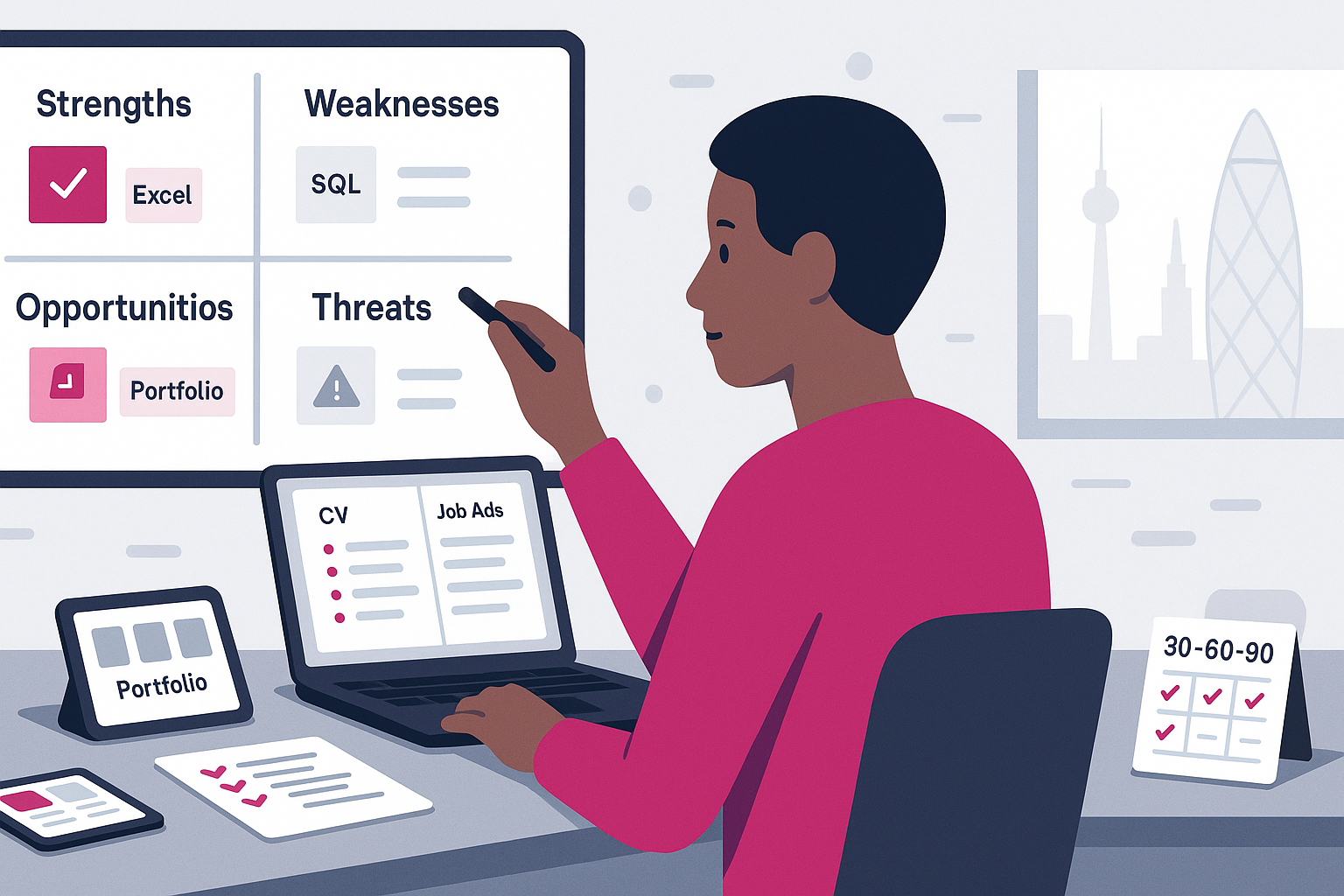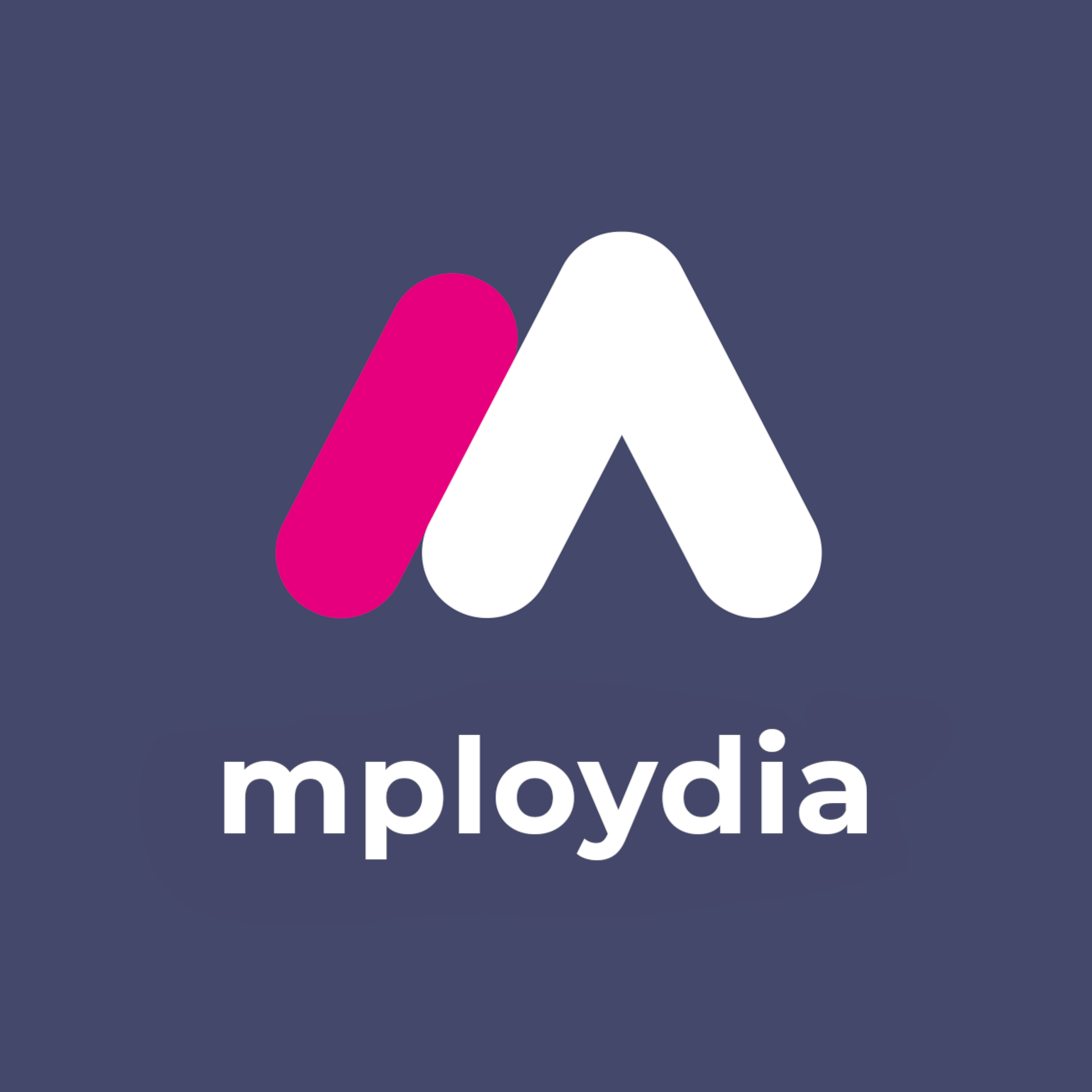
Personal SWOT for Career Planning: Map Strengths, Fix Gaps
Introduction: Stop Guessing Your Next Career Move
If you can’t clearly state your top three strengths, your key skills gap, and one market opportunity you can exploit in 90 days, you’re planning by guesswork. A personal SWOT analysis for career planning gives you a precise, evidence-driven way to choose roles, prioritise learning, and win interviews. Done properly, it removes noise, exposes blind spots, and turns uncertainty into a tactical plan you can execute now.
This guide is blunt, practical, and built for first-time jobseekers and early-career professionals who want results. You’ll get a step-by-step method, examples, templates, and a 30-60-90-day plan to turn your SWOT into action.
What Is a Personal SWOT and Why It Works
A personal SWOT analysis for career planning is a structured way to audit your Strengths and Weaknesses, and the external Opportunities and Threats in your target job market. You’re not journalling. You’re building a decision tool. The outcome is three things:
- Clear role targets you can win.
- A skills roadmap to close gaps fast.
- Messaging that proves your value to employers.
Why it works:
- It forces specificity. Vague claims vanish when you assign evidence.
- It aligns you with market demand, not personal preference alone.
- It converts self-awareness into measurable actions and results.
Set Up Your SWOT: Gather Evidence First
Never fill a SWOT from memory. You’ll bias it. Build a small evidence pack before you start.
Collect input from four sources:
1) You (self-audit)
- List projects, modules, competitions, voluntary roles, part-time work. Extract outcomes, metrics, and skills used.
- Gather certificates, GitHub links, portfolio pieces, presentations.
- Note tools and technologies used, with proficiency level.
2) Others (external feedback)
- Ask three people who have seen you work: “What do I do better than peers?” “Where do I slow the team down?” “What role would you trust me with?”
- Pull verbatim comments from appraisals, references, peer reviews, or lecturer feedback.
3) Market (demand signals)
- Scrape 15–20 job ads for your target roles. Note repeated skills, tools, and keywords. Prioritise those repeated three or more times.
- Scan LinkedIn profiles of people hired into your target roles in the past 12 months. Identify common experiences and certifications.
- Read two industry reports on hiring trends or growth areas in your sector.
4) Performance data (proof)
- Results, grades, awards, sales numbers, customer satisfaction scores, code commits, campaign metrics, process improvements, time saved. Anything countable.
Step-by-Step: Build Your Personal SWOT
Use this simple format:
Strengths: Internal, proven advantages you can demonstrate with evidence.
Weaknesses: Internal skill or behaviour gaps that limit performance.
Opportunities: External trends, niches, or pathways you can leverage.
Threats: External risks that could block or delay your progress.
Strengths: Identify, Prove, Deploy
Strengths must be specific and evidenced. Replace “good team player” with “coordinated 6-person team to deliver a university hackathon, 120 attendees, secured 4 sponsors.”
Prompts to find real strengths:
- Where have you created measurable results?
- What do people ask you to help with repeatedly?
- Which tools or methods do you use faster or more accurately than peers?
- What do you do under pressure that still meets the brief?
Evidence checklist:
- Metrics: numbers, percentages, time saved, error reduction.
- Artifacts: portfolios, links, code, designs, reports, presentations.
- Endorsements: feedback quotes, references, awards.
Example strength entries:
- Data interpretation: Led survey analysis of 420 responses. Produced insights that improved event attendance by 23%.
- Customer service: Part-time retail shift lead. Maintained 4.8/5 average customer rating over 6 months.
- Writing: Edited student society newsletter. Increased open rate from 21% to 36% in 8 weeks.
Weaknesses: Name Them, Rank Them, Fix Them
Weaknesses are not character flaws. They’re constraints. Good candidates know theirs and show a remediation plan.
Common early-career weaknesses:
- Tool gaps: Python for analysis, Excel advanced functions, SQL joins, Power BI.
- Behavioural gaps: time estimation, managing expectations, presenting to stakeholders, receiving feedback.
- Experience gaps: zero client-facing experience, limited commercial context, no project delivery end-to-end.
How to rank weaknesses:
- Impact: How much does it affect your target role performance?
- Frequency: How often will this matter on the job?
- Difficulty: How hard and how long to fix?
Turn each top weakness into a 30-day plan:
- Define one outcome: “Deliver a 5-minute stakeholder readout with clear recommendations.”
- Design a practice loop: weekly rehearsal, record yourself, get feedback, iterate.
- Ship a proof: publish a one-page summary, run a mock meeting, add to portfolio.
Opportunities: Exploit What the Market Gives You
Opportunities are external. You can’t control them, but you can position for them.
Where to find them:
- Industry growth pockets: fast-hiring functions or sectors.
- Skill shortages: roles with repeated mentions of specific tools you can learn quickly.
- Seasonal cycles: graduate schemes, internship windows, or retail peak hiring.
- Geographic and remote work openings: companies with remote-first teams or regional hubs.
- Non-traditional entry paths: apprenticeships, returnships, contract-to-perm roles, micro-internships, hackathons.
Examples:
- “SMEs hiring generalists who can handle customer support, simple data work, and process documentation.”
- “Healthcare tech companies expanding support analyst teams with training provided.”
- “LinkedIn shows rising demand for entry-level revenue operations with Excel and CRM basics.”
Threats: Anticipate and Mitigate
Threats are external headwinds.
Typical threats:
- Oversupply: hundreds of applicants for popular graduate schemes.
- Automation: some basic tasks handled by AI, shrinking low-skill roles.
- Credential inflation: employers asking for experience you don’t yet have.
- Economic slowdown: delayed hiring or rescinded offers.
Mitigation tactics:
- Narrow your niche: pursue smaller firms or sectors where your strengths are rare.
- Build undeniable proof: projects with measurable outcomes beat vague claims.
- Time your applications: apply within 48 hours of posting to beat the crowd.
- Build insider insight: informational interviews to bypass cold applications.
Convert SWOT into a Career Strategy
A SWOT is useless without decisions. Now turn insights into a plan you can execute.
1) Define target roles and hypotheses
- Pick up to three role titles you can plausibly win in 3–6 months.
- Write a simple hypothesis for each:
“Given Strengths A and B, I can land Role X by addressing Weakness C and showcasing Projects D and E.”
2) Score your options
Create a decision matrix. Score each role 1–5 on:
- Skill fit now
- Time to job-ready (gap size)
- Market demand (volume of roles)
- Differentiation (how unique your strengths are)
- Energy (your genuine interest)
Pick the highest total score. That is your primary target. Keep the second as a fallback.
3) Build a skills roadmap
For your chosen role, list 5–7 must-have skills from job ads. Classify:
- Ready now: ship proof this week.
- 30 days: quick upskill and publish.
- 60–90 days: deeper capability build.
4) Create OKRs for 90 days
Objective: Become job-ready for [Target Role] and secure interviews.
Key Results:
- KR1: Publish 3 portfolio artefacts proving skill X, Y, Z.
- KR2: Apply to 40 tailored roles, with a 15 percent interview rate.
- KR3: Conduct 10 informational interviews with professionals in target firms.
- KR4: Earn one certification or complete one verified course aligned to job ads.
5) Translate into weekly tasks
- Monday: role research and pipeline update.
- Tuesday: build or improve one portfolio artefact.
- Wednesday: networking outreach to 10 people.
- Thursday: tailored CV and cover letter for 5–7 roles.
- Friday: mock interview practice and review metrics.
Action Sprints: Your 30-60-90-Day Plan
30 days: Build proof and fix one critical weakness
- Produce one shipped project:
Data: Analyse a public dataset, create a dashboard, write a one-page insight brief.
Marketing: Run a small social campaign for a charity or society, report performance.
Customer success: Document a process playbook from a volunteer role, track issue resolution improvements. - Close one high-impact skill gap:
Take a structured micro-course and build something that demonstrates it. The deliverable matters more than the certificate. - Set up your system:
ATS-friendly CV, targeted LinkedIn headline, basic portfolio page, simple tracker for applications and outreach.
60 days: Grow credibility and network
- Publish two more artefacts with measurable outcomes.
- Conduct 6–8 informational interviews. Convert two into referrals.
- Join one community relevant to your role. Contribute weekly.
- Improve interview assets: STAR stories with numbers, a clear 60-second pitch, and a 5-slide value proposition deck.
90 days: Scale applications and convert
- Maintain a pipeline of 30+ live roles.
- Tailor every application. Mirror the employer’s language in your CV bullets.
- Run weekly mock interviews. Record, review, refine.
- Negotiate one freelance, contract, or volunteer project if full-time offers are slow. Keep shipping proof.
Examples: SWOTs for Common Early-Career Paths
Example 1: Data Analyst (Entry-level)
Strengths
- Excel advanced (INDEX MATCH, pivot tables). Cleaned and analysed 15k-row dataset for society membership drive, +23 percent sign-ups.
- Basic SQL. Wrote queries with joins to combine sales and product tables in a course project.
- Visualisation. Built Power BI dashboard to track student attendance, shared with faculty.
Weaknesses
- Limited stakeholder presentation experience.
- Python for data cleaning not yet confident.
Opportunities
- Many SMEs want analysts who can automate reporting with Excel/Power BI.
- Growth in roles titled “Data Analyst” and “Insights Analyst” with on-the-job Python training.
Threats
Actions
- Ship three artefacts: 1 Excel automation with before/after time saved, 1 Power BI dashboard with narrative, 1 SQL case study.
- 30-day Python sprint: clean a public dataset, publish notebook, write a short methods note.
- Present a 5-minute readout to a peer group weekly for four weeks.
Example 2: Marketing Assistant
Strengths
- Copywriting. Edited society newsletter, CTR from 2.1 percent to 3.6 percent.
- Social content planning. Built 4-week calendar for charity drive, +18 percent follower growth.
- Basic Canva design.
Weaknesses
- Limited analytics depth beyond platform dashboards.
- No campaign budget management.
Opportunities
- Start-ups hiring content generalists who can write, schedule, and report.
- Local SMEs needing email lifecycle basics more than brand campaigns.
Threats
- AI-generated content flooding the market, lowering average quality.
Actions
- Run a small £50 paid campaign for a local cause, report CAC and CTR.
- Learn UTM tagging and build a simple campaign report in Google Looker Studio.
- Create a 2-page content playbook with tone, cadence, and metrics.
Example 3: Customer Success Associate
Strengths
- Conflict resolution. Retail shift lead, maintained 4.8/5 rating.
- Process documentation. Wrote a returns SOP that cut average resolution time by 19 percent.
- Empathy and active listening.
Weaknesses
- No SaaS tools experience.
- Limited exposure to onboarding and QBRs.
Opportunities
- SaaS companies expanding CS teams to protect revenue.
- Willingness to hire for attitude and train on tools.
Threats
- Some firms merging CS and support, raising workload and context switching.
Actions
- Learn a popular CRM’s basics and document a mock onboarding flow.
- Volunteer to onboard users for a community tool, collect testimonials.
- Build three STAR stories focused on churn risk, escalation, and expectation management.
Craft Messaging From Your SWOT
Your CV, LinkedIn, and interviews must reflect your SWOT insights.
CV
- Headline: Target role and top skills aligned with job ads.
- Bullets: One line each. Start with a strong verb, include a metric, end with the method or tool.
- Order: Put the most relevant projects and experience first.
- Headline: “[Target Role] | [Top 3 Skills] | [Outcome]”.
- About: 3 short paragraphs: strengths with proof, the value you deliver, what you’re targeting next.
- Featured: Link to your three best artefacts. Add short context lines.
Interview
- 60-second pitch: who you are, the value you deliver, proof, and why this role.
- STAR library: 6–8 stories tied to common competencies. Keep numbers front and centre.
- Questions: Ask about priorities, success metrics, and the first 90 days.
Avoid These Common SWOT Mistakes
- Vague strengths. If it lacks proof, it’s not a strength yet.
- Laundry-list weaknesses with no plan. Pick the top two and show progress.
- Generic opportunities like “tech is growing.” Identify specific roles, tools, and firms.
- Fear of threats. You’re not pessimistic for naming risks. You’re professional.
- Overfitting. Don’t twist your profile to fit a role you dislike. You’ll quit.
Advanced Tactics to Multiply Your Results
- Keyword alignment: Map your SWOT to ATS keywords. Use exact phrases from job ads in your CV where truthful.
- Portfolio-first applications: Include a link to a relevant artefact in your CV top third and cover letter. Make it unavoidable to click.
- Referral compounding: After each informational interview, ask, “Who else should I speak to?” Close with a concise, quantified summary of what you’re building.
- Public build: Share short weekly updates on LinkedIn showing your progress and results. Visibility attracts opportunities.
- Value proposition slide: A one-page “Here’s what I’ll deliver in my first 90 days” based on your opportunities and the firm’s pain points.
Make It Live: Review Cadence and Metrics
Review your SWOT monthly. Markets move. You should too.
Weekly metrics to track:
- Applications sent and interviews secured.
- Informational interviews completed.
- Portfolio artefacts published.
- Skill progress milestones hit.
- Response rate to networking outreach.
Pivot triggers:
- Zero interviews after 30 targeted applications: tighten fit or improve artefacts.
- Consistent feedback on the same weakness: prioritise a fix next sprint.
- Market shift in job ads: adjust your skills roadmap.
Templates You Can Copy
SWOT Grid
- Strengths: [Bullet list with proof]
- Weaknesses: [Bullet list with one fix plan each]
- Opportunities: [Specific, market-validated]
- Threats: [Named plus mitigation]
Decision Matrix (score 1–5)
- Role A: Skill fit [ ], Time to ready [ ], Demand [ ], Differentiation [ ], Energy [ ]. Total [ ].
- Role B: Skill fit [ ], Time to ready [ ], Demand [ ], Differentiation [ ], Energy [ ]. Total [ ].
30-60-90 Plan
- 30 days: Ship 1 artefact. Close 1 high-impact gap. Set up application system.
- 60 days: Ship 2 artefacts. 6–8 info interviews. Improve interview assets.
- 90 days: Scale tailored applications. Weekly mocks. Secure project if needed.
One-Page Value Proposition
- Problem I’ll help you solve: [Employer pain]
- What I’ll deliver in 90 days: [Three measurable outcomes]
- Proof I can do it: [Two artefacts with results]
Closing Argument: Pick a Direction, Then Build Proof Relentlessly
A personal SWOT analysis for career planning is not paperwork. It’s a power tool. Use it to choose roles strategically, close gaps with intent, and communicate value with precision. If you ship proof every week and align it to market demand, you’ll stop competing on potential and start competing on results. That’s how you get hired.
Next Steps
Want to learn more? Check out these articles:
Must-Have Soft Skills Employers Seek for 2025 Success
Mastering Professionalism: Your Guide to Workplace Success
Why Initiative is Crucial in Modern Work Environments
Check out our Advanced Employability Course for all the help you need to get your dream job, fast.


